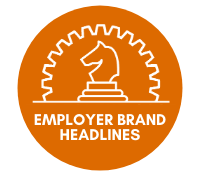Employer Brand Headlines: The "Rush Hour" Edition (#93)
My mission: Help you understand your employer brand better and make it work for you.

In this issue
Blind trolls
Pattern recognition
Sparking your creativity
The end of hybrid work (already?)
The big idea
I’ve been spending a little too much time on Blind lately. (Don’t know Blind? It’s the app that lets anonymous 28-yo Bay Area developers complain about their $210k+RSUs comp plan 🙄 .)
I don’t know if it’s Blind or the industry or the location, but something I’ve noticed is that there is a lot of ranking of companies. That’s nothing new (plenty of companies make most of their revenue doing exactly that), but what I find fascinating is someone posting without equivocation that companies A, B, and C are “top tier,” that companies, L, M, N, and P are “mid-tier” and that Companies X, Y, and Z are “shit tier,” and then dozens (if not hundreds) of others confirm that ranking.
It’s endemic to the ecosystem: the unending claims that my company is “better” than yours. For example, someone at Microsoft says that Amazon is a crap company to work for. Someone from Amazon responds that Microsoft sucks. This sparks a growing argument of which company is “better.” Others chime in. Insults are thrown. The post collects interested parties as if this is a conversation that will “solve” anything. Getting on Blind and saying some other company “sucks” is like picking a fistfight in jail: it’s exciting and messy, but it’s not like there’s anything to really “win” other than bragging rights with fellow prisoners.

The underlying issue is that maybe to someone, Amazon is an amazing company to work for. And to others, Microsoft is equally amazing as an employer. They aren’t the same and really you can’t compare the two. It’s like deciding who’s a better artist: Prince or Van Gogh. On what basis is there any comparison? What is the value of a decision?
Sadly, the value to the troll on Blind is obvious. Being able to call another company “crap” makes the accuser look good because they don’t work for such a “crap” company. Every accusation has some factual basis (sorry: there’s no such thing as a perfect company: even companies with five-star ratings on Glassdoor can feel like a cult after a while). Every company has something imperfect about it. Every. Single. Company. So there’s ample ammo if you’re looking to pick a fight.
But what’s crucial to remember for you and me is that these fights aren’t just happening in some anonymous app. They are happening in the minds of prospects, candidates, and employees. If you are hiring at a bank, you have to know that the candidate is wondering, “will people think I’m boring because I work in a bank?” If you are hiring at a startup, you know that the candidate will think, “will people think I’m crazy for taking a job at a company that might not work?”

Call it the “spouse question.” Will your significant other, parents, or network think more or less of you for having selected this company?
The power of employer brand isn’t in how many applicants you attract or your time to fill. It’s in how well you can plant the seeds of the story you want candidates to tell themselves when they consider working for you. How will they fight back when the trolls start throwing mud about their business? If your brand is all about being “great” (defined in whatever thin manner you have available), they are walking into the fight with a cardboard knife. But if they have a strong sense of “why,” they can handle whatever the trolls throw.
Headlines!
Solving Brand Crisis By Breaking Patterns
Brands exist in many ways as repeated patterns. Saying you are a caring employer isn’t nearly as important as the hundred little ways an employer shows that it cares (and what about). But sometimes, you need to pivot and change. In these cases, the answer might be in breaking your pattern in an obvious and intentional way.
www.brandingstrategyinsider.com • Share
Interview: Make It About Micro-Actions, Not Big Gestures
See above regarding patterns.
Patagonia shows corporate activism is simpler than it looks
Also regarding patterns: It’s a lot easier to take a stand if you’re deeply consistent.
How to Become a Top Global Employer with Empowered Brand Ambassadors
I’m not 100% sold that brand ambassadors are any kind of silver bullet to effective brand management (at least as seen on its own). But you’d be a fool to ignore the power of what your brand champions (in and out of the org) can do.
www.brandingbusiness.com • Share
A Data-Driven Approach to Identifying — and Retaining — Top Employees
As someone who’s seen the 9-box grid game played from the inside (it makes sausage-making seem clean by comparison), I’m glad some people are looking for other cues to indicate that who really moves a company and who doesn’t (no matter how much their manager likes them).
Our Brain Typically Overlooks This Brilliant Problem-Solving Strategy
Creative thinking starts by rejecting received wisdom. But how do you see the puppet strings that come with received wisdom? Start by removing something. (See also: add an arbitrary constraint)
www.scientificamerican.com • Share
High-Performing Teams Start with a Culture of Shared Values
It’s possible that tribalism is innate, suggesting that no amount of kumbaya “all together now!” thinking will bring an entire company together. So how do you build a culture where people are performing instead of plotting against each other?
The hybrid workplace probably won’t last
And why don’t men wear hats anymore?! I was absolutely stunned by the mental gymnastics in evidence that allowed the author to claim that hybrid working is bad across the board (so much eye-rolling) without saying “your boss just doesn’t trust you!” This article gets more revealing when you read it in Mr. Burns’ (Simpsons) voice. ‘Those rapscallions and ragamuffins trying to make a better life for themselves…’
5 Types of Recruitment Videos Inspired by YouTube
What trends on YouTube can you take advantage of to keep from making yet another “generic employer brand video”?
A Tale of Two ‘Scandals’ and What They Can Teach Us about Employer Branding
Yeah, I wrote a thing…
employerbrandwagon.com • Share
What Is an Entertainment Company in 2021 and Why Does the Answer Matter?
Crazy long read, but insightful as all get out. In particular, I love the idea that having control of intellectual property is no replacement for knowing what to do with it.
Quick hits
Tip of the week
Take two hours this week and re-vamp one visual piece of collateral. Either the LinkedIn banners you offer recruiters and staff or a sticker you hand out. Visuals go out of date in a hurry, so give yours a refresh before they start to feel stale.
Inside the fortune cookie
“A true artist is not one who is inspired, but one who inspires others.” -Salvador Dali
This is not a commerical
Think about how much time, money and energy you spend trying to attract new talent and how little you spend keeping great talent. Hence: worqdrive. When fewer people leave, you can focus on hiring better talent (This is not a commercial. No one incentivized me to share this. Tracey is a friend and I love to promote my friends’ work)
Thanks, everyone!
There are now more than 800 links in the link archive.
And as always, when you reply to this email I will read your questions and comments. Is there any article I should be commenting on? A book? A podcast? Is there something you what to know? How can I help? Just reply to this email and it comes directly to me.
Cheers and thanks!
-James Ellis (LinkedIn | Twitter | Podcast | Articles)
Where the subject line came from:

Jane Wiedlin - Rush Hour (promo video)

By James Ellis, Employer Brand Nerd
In a sea of content, how do you stay up to date on employer branding news? How do you know what's worth reading and what's just a waste of time?
So glad you asked! Here's a weekly digest of the best content to make you smarter about employer branding, curated by James Ellis.
In order to unsubscribe, click here.
If you were forwarded this newsletter and you like it, you can subscribe here.
Powered by Revue
James Ellis, 421 W Melrose, Chicago, IL 60657




